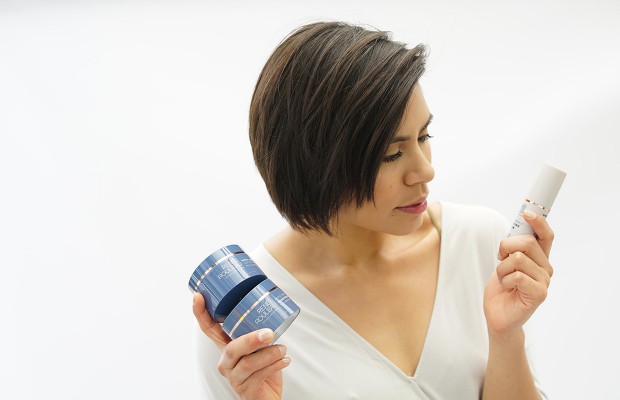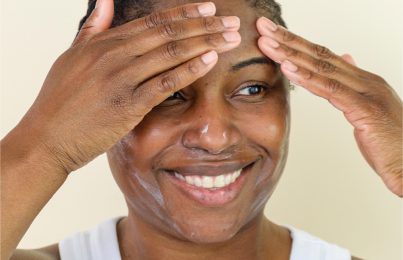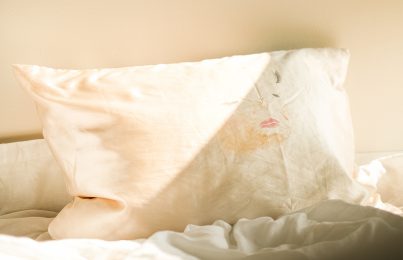Updated 12/1/17. I often hear people describing their skin as “dry on top but oily underneath.” Well, I’m here to set the record straight—you can’t have both dry and oily skin. If your skin is producing oil but still feels “dry,” what you’re actually experiencing is dehydration. Keep reading to learn how to fix this problem and how to differentiate between dry and dehydrated skin.
What is Dry Skin?
Dry skin is classified as skin that produces little to no oil and has small pores. This lack of oil causes dryness and flakiness, especially with age. Dry skin is a genetic condition. Some people are just born with fewer oil glands than others.
What is Oily Skin?
Oily skin is classified as skin that produces oil and has visibly larger pores. This causes the skin to get greasy and have a shine. Oily skin is a genetic condition characterized by active oil glands. Oily skin types are prone to clogged pores and breakouts.
What is Dehydrated Skin?
Dehydration is a temporary skin condition, not a genetic skin type. It is often found in oily, combination or normal skin that is lacking water (not oil), which causes the skin to feel tight. (Watch this quick video to see what dehydrated skin looks like.)
I often hear people with oily skin types saying their skin is feeling dry, but they’re still getting breakouts and aren’t sure how to treat this combo. This is a telltale sign that someone is dehydrated. If you’re getting breakouts or clogged pores, your skin is producing oil. If your skin is producing oil, you can’t be a true dry skin type. It’s that simple!
To remedy what feels like both dry and oily skin, these people might start using a heavy moisturizer formulated for dry skin, but this can cause more clogged pores, bumps, and breakouts. Sound familiar? Sometimes they think it’s because they don’t drink enough water, but hydration levels in the skin have very little to do with drinking water, despite what you’ve always been told.
The truth is that if your skin is naturally oily but acting “dry,” the underlying issue is probably something to do with your skincare routine. You may be using something too harsh.
Learn more about the differences between dry and dehydrated skin, as well as how to best care for it.
How to Treat “Dry and Oily” (A.k.a Dehydrated) Skin
In my thirty years as an esthetician, I’ve observed that the underlying cause of dehydration is usually harsh or drying skincare products. Here are some of my expert tips to get your skin healthy and balanced and alleviate the tight feeling caused by skin dehydration.
Choose Your Cleanser Carefully
Many foaming or gel cleansers are still formulated with ingredients called Sodium Lauryl Sulfate, Sodium Laureth Sulfate or Ammonium Laureth Sulfate. These are known as surfactants, which are cleansing agents that cut oil from the skin. While oily skin types do need the oil and shine to be broken down and removed by a cleanser, these ingredients are not in alignment with your skin’s natural pH and will strip too much water out of the skin after every washing. This is what leads to dehydration.
It’s important to know that what you cleanse with is the MOST important part of your skincare routine. Why? Because if you wash with a cleanser or soap that is too strong and drying, it pulls all the water out of the skin and creates a buildup of dead skin cells. The rest of your routine is then dedicated to trying to make up for this dehydration. When buying a cleanser, look for the words ‘sulfate-free’ on the bottle as this will imply that it’s a safe formula. You can get your skin properly cleaned while keeping the water in your skin where it belongs. Every good skincare routine should begin with a gentle cleanser.
Never Leave Your Skin Bare After Washing
After cleansing, you should quickly layer on an alcohol-free toner, serum (optional), and moisturizer. If you leave your skin bare for more than sixty seconds, it will start to dehydrate. After cleansing, it’s best to immediately apply an alcohol-free toner and then leave it damp on the skin when applying your next product. This way, your serum or moisturizer will lock in the hydrating benefits found in a toner.
Never Skip Moisturizer at Night so Your Skin Can “Breathe”
People with acne-prone skin are often worried about using moisturizer. They believe that it will clog their pores and not let the skin “breathe.” There are a few problems with this type of thinking. First, wearing moisturizer does not directly cause breakouts. Acne occurs when the cells that line the inner pores fail to fall off properly and the pore becomes clogged. This process happens whether you moisturize or not.
Second, respiration doesn’t happen in the skin. The concept of your skin breathing is false.
Those with oily, blemish-prone skin must use moisturizer no matter what. Your skin needs sufficient water to keep it healthy and balanced. The more balanced the hydration levels in your skin, the less likely it is to break out. Skipping moisturizer disrupts the skin’s water levels causing that “oily and dry” feeling we are talking about. This dehydration process actually stimulates more oil production, which potentially causes more breakouts.
The key here is to choose a moisturizer that is suitable for your skin type. Dry skin types need moisturizers that deliver oil into the skin while oily skin types require a moisturizer that gives water.
Use a Humidifier During the Winter Months.
If the air is moist, then the moisture in your skin will likely stay put rather than evaporating into the dry winter air. Learn more about how a humidifier can benefit your skin (and health!).
Use a Serum Underneath Your Moisturizer.
By applying a few drops of a lightweight, water-based skin serum underneath a moisturizer, you’ll get much-needed hydration to alleviate that tight feeling. I usually suggest that my clients with oily skin use Skin Drink Concentrate.
In summary, if you feel like you have dry, oily skin and your skin is feeling tight, you simply need to use a skincare routine that does a better job at balancing the water levels in your skin. It’s an easy fix!
Celebrity Esthetician & Skincare Expert
As an esthetician trained in cosmetic chemistry, Renée Rouleau has spent 30 years researching skin, educating her audience, and building an award-winning line of products. Her hands-on experience as an esthetician and trusted skin care expert has created a real-world solution — products that are formulated for nine different types of skin so your face will get exactly what it needs to look and feel its best. Trusted by celebrities, editors, bloggers, and skincare obsessives around the globe, her vast real-world knowledge and constant research are why Marie Claire calls her “the most passionate skin practitioner we know.”




Comments:
Hi Renee
Your blog is really good and it helps me with the issues I am facing currently.
I am 31 and I had a clear skin all these years. I skin was very dry too. Since the past 6 months my skin is full of break-outs and has become very oily. I have changed my moisturiser to a water based one to help with this and am also using a toner.
I got a facial on Tuesday and lazer hair removal treatment (I am doing this since December 13 – every 6-8 weeks) done on Wednesday. Since then I have had too many break outs. The break-outs have lessened by now but I feel my skin is extremely dry and flaky on my cheeks since Thursday/Friday.
I am not sure what is causing the breakouts which never bothered me all these years and what’s causing the dry flaky cheeks. The lady who does my facial said the cheeks are dehydrated. Not sure what is causing this. can you please help.
Thanks a lot.
Posted By: Chandni |
To balance the needs of both dry skin as well as breakouts you need a product like BHA Clarifying Serum which can be purchased here. Most acne products will only dry out your skin further and cause more irritation and breakouts. You can see more here https://www.reneerouleau.com/products/bha-clarifying-serum Then alternating at night with this will help too. https://www.reneerouleau.com/products/skin-correcting-serum I hope reading the blog posts will help you, too. You can also schedule a virtual consultation with us to get expert advice from an esthetician. Info here https://www.reneerouleau.com/spas/virtual-consultations
Posted By: Renée Rouleau |
Hi Renee, I’m having problems figuring out my skin type. I took your quiz and it said I’m skin type 2 but I’m still unsure.
My main problems are , when I was my face , afterward my skin feels dry and tight when I put oil free moisturizer on it looks oily and gross. I have been using image skin care products and they are sulfate free etc.. I am also suffering from clogged pores/ blackheads on my nose chin and clogged pores on my cheeks near my nose. I also have large pores and laugh lines by my mouth and I’m only 30 years old. I’m so desperate to find something perfect for my skin. I need your help!!
What do you think?
I hope to hear back from you.
Thank you.
Posted By: Amanda |
Hi Amanda,
After you wash if your skin feels tight (and you’re using a gentle, sulfate-free cleanser) it means that you are waiting too long to apply your next product. After washing, pat your skin lightly and immediately wipe over an alcohol-free toner like our Elderberry Toner. By leaving it wet and then applying your serum or moisturizer, you’re sealing in all the hydration. It sounds like if your skin is feeling dry, the moisture fro washing your face with water is evaporating out of the skin. You never want to leave the skin bare for longer than 60 seconds (at the most) before applying your next product. That should help. As for your skin type, it definitely sounds like you’re a skin type 2 so check out that routine. It’s a great one for you!
Posted By: Renée Rouleau |
Hi there,
When I wash my face in the morning it gets really really dry and flaky. Then I put moisturiser in but after a few hours my skin get gets really greasy and oily to the point it even feels heavy.
I use a facewash for oily skin prone to imperfections and then moisturise with aloe vera gel.
Can you help? Do you know why this is? I am going crazy as I keep getting spots that hurt quite a bit…
I hope to hear from you!
Thank you!!
Posted By: laluar01 |
You have to use a sulfate-free cleanser. Chances are the cleanser you are using is way too strong and drying out your skin, especially if you’re getting dry and flaky. The aloe vera gel is not hydrating enough. It’s a gel and while it will hydrate immediately, as it drys, it will evaporate and not hold water in your skin. Because your skin is not getting the hydration it needs, it’s over compensating by producing excess oil. Take our skin type quiz to get the right products recommended for your skin’s needs. https://www.reneerouleau.com/skin-types
Posted By: Renée Rouleau |
Hi Renee, I have combination skin, I am currently using himalaya products, my skin is dehydrated and gets oily and dull, I am breaking out like crazy and its really lowering my self esteem because I have never had skin problems before. Every pimple leaves an awful mark on my face and I don’t know what to do, please help
Posted By: sherry |
Hello Sherry, I’m sorry you’re having such difficulties with your skin. You would really benefit from using my products but first, read through my acne posts to get free tips. Read here: https://blog.reneerouleau.com/
Posted By: Renée Rouleau |
I have the #3 skin type and use matte moisture after cleansing and toning (AHA/BHA cleanser and Skin Balancing toner) but am finding that my skin is still feeling dehydrated (flaky at times and tight). I still produce oil (in t-zone) so after reading this post, I realized my skin isn’t dry, just dehydrated. Would you recommend using a heavier moisturizer than matte moisture or use a serum, like skin drink under the matte moisture? Thanks!
Posted By: Alex |
Yes Alex, you definitely need a heavier moisturizer. Look at the Sheer Moisturizer (still oil-free but more hydrating) or even the Hawaiian Nourishing Cream, especially in winter. Both are appropriate for skin type 3.
Posted By: Renée Rouleau |
Thanks so much! That helps a lot! In terms of a morning moisturizer, would you recommend the daily protection or the age defense (for more moisture?) or a different one?
Posted By: Alex |
The Daily Protection SPF 30 is our most popular. It’s very, very light.
Posted By: Renée Rouleau |
Hi Renee,
I think this blog post explains it great.
I have oily, to combination skin, because I have really badly clogged pores and blackheads. And, since my skin feels tight and is quite flaky, yet still is only on top, it’s dehydrated. Also, if it makes sense, the clogged pores and blackheads (especially on my forehead) seems to dry up, so it’s really a dry and hard little bump.
Problem is, for me, that I do use a gentle cleanser, and I use natural oils and serums that are supposed to balance my skin without stripping it, but something is still not working – the flakiness is still there, and what’s worse is that I think it contributes to the clogged pores beacuse the flakes sit on top of the skin. I’m having a really hard time both balancing my skin to avoid clogged pores and keeping it hydrated. It tends to get better, but then more flakes appear. At the end of the day, my skin is oily (not super oily though), with a sheen, flaky, with those dry hard bumps, and more clogged pores have appeared..
What do you suggest I do? (I have already ordered your BHA serum, so that’s on its way).
Thanks,
Lisa
Posted By: Lisa |
Dear, Renee.
I’m 21 y.o and I really confused with my skin. I have very big pores on my nose and cheeks but it’s not too oily. If i didn’t wash my face for months i won’t got acne, but no matter what I do my face always full of blackheads and whiteheads which is really stand out. I found that if I rub my face with cleansing oil for at least 3 minutes twice a day my blackheads getting better. But if I rub my face, it becomes redness and really hurt my skin, even if i do that powerless. It really makes me give up and so sad. Because there are so many white things on my pores which are really disgusting. I just bought Retin-A 0,025% but im really afraid it would hurt my skin, because people said it would exfoliate your skin, really hurt and breakout. My skin is very sensitive (cleanse my face twice a day hurts my skin).
What Im using now:
Kose cleansing oil
Double hylarunoic acid face wash
Green tea and tea tree oil toner (alcohol free)
Lotion (contains retinol, improved hylarunoic acid, collagen)
Thank you so much, Renee.
With love, Anna.
Posted By: Anna |
Hey Renee,
Have you ever considered including facials in your routine? I have found that including a full facial once a week where i steam my face, exfoliate, do a mask , extract and then moisturize have really helped to reduce whiteheads on my face over time.
Posted By: Tricia |
Hello Tricia, Yes, at-home facials are extremely beneficial to the skin.
Posted By: Renée Rouleau |
oops, sorry! you did specify skin dampened with toner. Thanks again! 🙂
Posted By: Lee Ann |
Thank you, Renee for answering me. Super helpful! do you think it’s wise to apply the Retin-A while my skin is still damp with toner? or water-dampened skin? I will certainly take your advice on applying moisturizer 20 minutes post-Retin-A application. I just need to make sure this all happens early in the night, not when I’m super tired and can’t be bothered waiting all of that time! lol thanks again, you’re the best.
Posted By: Lee Ann |
Hi,
I know that Renee emphasizes the fact not to leave skin bare for more than one minute after cleansing, otherwise the skin will get very dehydrated. But the problem with this is that I’m on Retin-A, and the rule is you have to wait at least 20-30 minutes to apply it after you wash your face. Any suggestions? I don’t even apply a moisturizer over Retin-A…I leave it alone because I’m afraid that a moisturize may compromise the efficacy of the Retin-A.
Posted By: Lee Ann |
Hi Lee Ann, It’s Renee here. GREAT question. So the reason why they say to wait for 20-30 minutes after washing your face before you put on Retin-A is to reduce sensitivity and irritation. Moist skin (when the skin cells are moist from water after cleansing) is 10x more permeable than dry skin. So this means that if you apply Retin-A when the skin is moist, it will penetrate deeper in the skin (which actually makes it work better) but then since it’s working better (stronger) you’re more likely to get irritation/dryness/peeling etc… The goal with Retin-A is to try to minimize the irritation so that you’ll stick with it long-term since so many people give up the moment irritation occurs. As for not applying moisturizer over Retin-A, I don’t recommend doing that as dehydration (especially when using Retin-A) is never healthy to the skin cells. I use my Advanced Resurfacing Serum with retinol as I have very sensitive skin and my skin can’t tolerate Retin-A but if I were to use Retin-A, I would use it this way. Cleanse, tone, leave toner damp, apply Retin-A, then wait 20 minutes for it to really absorb into the skin. Then apply moisturizer. Doing it this way will really allow the Retin-A to perform its best while not compromising the healthy and integrity of the skin. Hope this helps! Read this post as you’ll find it interesting. https://blog.reneerouleau.com/2012/07/the-fountain-of-youth-do-retinol-products-really-get-rid-of-wrinkles/
Posted By: Renée Rouleau |